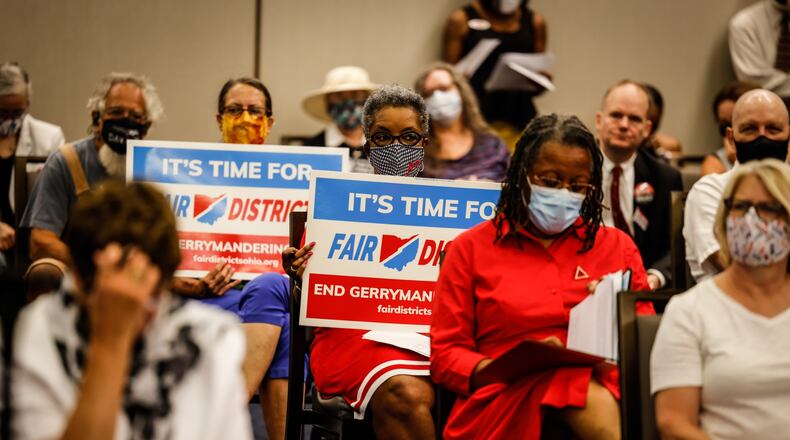Many in the crowd held signs from anti-gerrymandering activist group Fair Districts Ohio.
Speaker after speaker decried gerrymandering, urging commissioners to draw district lines that aren’t calculated to maintain partisan advantage.
“Gerrymandering provides the illusion of democracy, but actually denies it,” said Laurel Kerr of Washington Twp. Like several others, she blasted the 2011 redistricting effort that she said results in most General Assembly seats being decided in a partisan primary, often by the most extreme candidate.
“Every American should have the right to vote and have their vote have equal influence in the government that results,” said Stanley Hirtle, chair of the social justice and peacemaking ministry at College Hill Presbyterian Church in Dayton. “Many do not believe they should participate in a process that is stacked against them.”
Mattie White, first vice president of the Dayton NAACP, was joined as she spoke by several of her sisters in Delta Sigma Theta sorority. Republicans win about 54% of the vote in Ohio, but hold 65% of state House seats and 75% of Senate seats, demonstrating the effects of gerrymandering, White said.
She and others said that current district maps were deliberately drawn to split minority votes, diluting their impact by attaching them piecemeal to rural, overwhelmingly white populations.
Public speakers were limited to four minutes each, and commission members listened almost without asking questions, some occasionally taking notes.
The Ohio Redistricting Commission is co-chaired by state House Speaker Robert Cupp, R-Lima, and state Sen. Vernon Sykes, D-Akron. Its other members are Gov. Mike DeWine; Auditor of State Keith Faber; Secretary of State Frank LaRose; Ohio Senate President Matt Huffman, R-Lima; and House Minority Leader Emilia Sykes, D-Akron, daughter of Vernon Sykes.
Credit: Jim Noelker
Credit: Jim Noelker
While LaRose and Vernon Sykes attended in person, all other members sent designated proxies: state Rep. Phil Plummer, R-Dayton, for Cupp; Deputy Chief of Staff Alex Bilchak for Faber, whom Bilchak said was tied up at other events; House Assistant Minority Leader Kristin Boggs, D-Columbus, for Emilia Sykes; and state Sen. Louis Blessing III, R-Colerain Twp., for Senate President Matt Huffman. Vernon Sykes noted that Huffman entered the room shortly before noon, but didn’t join the panel.
DeWine, the only commission member from the Dayton area — his home is in Cedarville — sent Matthew Donahue, his chief legal counsel. DeWine attended Cincinnati Bengals practice instead of the two redistricting meetings Monday, drawing denunciation from voting rights groups.
DeWine also spoke at a Teamsters annual conference in Columbus on Tuesday and had meetings scheduled through the afternoon, his Press Secretary Dan Tierney said. During previous redistricting processes, governors and other participants have traditionally sent proxies to public hearings, he said.
DeWine will review materials presented at the hearings, Tierney said.
Tierney said that part of DeWine’s responsibilities as governor is to promote “all things Ohio,” and that his presence at Bengals football practice had been scheduled before the redistricting hearings.
Several speakers at the Dayton hearing complained that the public hearings are all scheduled on weekdays during normal working hours — starting at either 9:30 a.m. or 2:30 p.m. — making it hard for many people to participate.
Vernon Sykes said there would be more hearings beyond the current series, but didn’t provide specifics.
Two meetings took place Monday in Cleveland and Youngstown, and another in Cincinnati on Tuesday afternoon. The rest are:
· 9:30 a.m. Wednesday, Aug. 25, at Ohio University in Zanesville.
· 2:30 p.m. Wednesday at Rio Grande Community College.
· 9:30 a.m. Thursday, Aug. 26, at Ohio State University in Lima.
· 2:30 p.m. Thursday at the University of Toledo.
· 9:30 a.m. Friday, Aug. 27, at the University of Akron.
· 2:30 p.m. Friday at Ohio State University in Mansfield.
Based on 2020 census figures, the 99 state House districts will each represent about 119,000 people, and each of the 33 state Senate district will represent 357,000, Vernon Sykes said.
Voters approved a constitutional amendment in 2015 to create the bipartisan state legislative redistricting commission. Reflecting state government’s current makeup, the Ohio Redistricting Commission has five Republican and two Democratic members.
If at least two commissioners from each major political party vote to approve a new district map, it’s valid for 10 years. If a map passes on partisan lines, it’s only good for four years.
The state legislative map must be completed by Sept. 15 at the latest.
“Since the last maps were drawn, Ohioans have twice voted to reform the redistricting process,” said Scott DiMauro, president of the Ohio Education Association and a social studies teacher from Worthington. He referred to the state redistricting amendment and the similar 2018 amendment on redrawing Congressional districts. Based on 2020 census results, Ohio will lose one of its 16 U.S. House seats in the upcoming redistricting.
Partisan gerrymandering results in a government that is less responsive to constituents and more polarized, DiMauro said.
Boggs issued a statement urging everyone to attend a hearing or submit their testimony online. More information, including online submission, at https://redistricting.ohio.gov/.
About the Author




